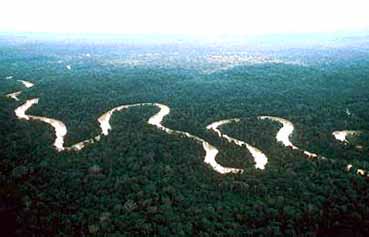 |
This is the image you see from your plane window when approaching the city of Manaus. Green sea, Amazon Jungle, Rain Forest, or whatever you prefer to call it, it really doesn’t make much difference. It’s something you have probably never seen before, and a place that very often use to make people feel somehow strange. As if you were getting to some place lost in time or out of the world you knew so far. |
Between Manaus, a modern city itself, and the rest of the so called civilized world, there will be thousands of miles covered with swirling rivers, hidden waters pretending to be grass, and tall and thick threes of all shapes. In most of the places you won’t be able to tell the limits between each one of them. What am I doing here, I asked myself the first time I went there. I didn’t know yet, but that was the starting point of one of the most memorable experiences I had ever had. The chance to know a truly nature sanctuary. One of those places that, once you have met, you will never forget. |
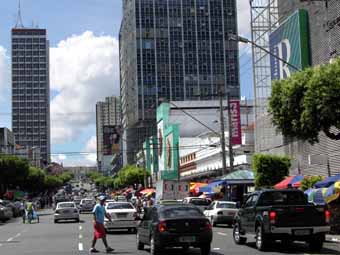
|
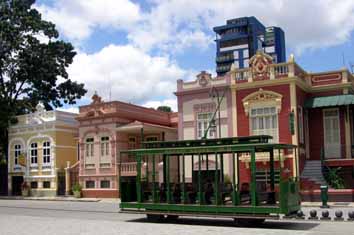 |
Metro Manaus area is also worth exploring. To learn more about the natives of Rio Negro visit the Indio Museum. Walk along the beach at Ponta Negra, and try some of the many local fruits ice creams, or the famous Tacaca, most popular traditional dish in the Amazon. It is also worth visiting the neoclassical Public Library building (57 Barroso St), dating from 1870. See the large oil painting honoring the end of slavery in the Amazon. At right Negro (Dark) River. At left, traditional downtown mansions. |
Visit also the Old Customs House (Alfandega), on Marquesa da Santa Cruz St, which was prefabricated in England in 1912, shipped in pieces, and reconstructed in Manaus. The tower on the water side of the building was once a lighthouse. Praca da Policia is the downtown square heart, with many cafes and restaurants around. Manaus is very hot, so this is a good place to relax and drink a very cold beer or soft drink. At right, a modern residential area facing Rio Negro. |
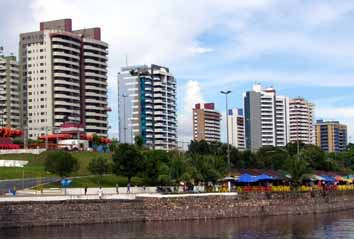 |
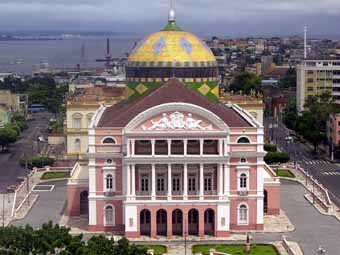 |
At left, Teatro Amazonas (Amazon Opera House), built in the Opera de Paris style and main architectural landmark in the city. Behind it, next to the horizon, you can see part of the Negro River. Manaus has a 1.6 million population. It is located on the shores of Rio Negro, just upstream from where it joins the Solimoes River. Just some miles ahead, the two of them become the mighty Amazon. More than 4,100 miles long, this is, as you probably know, the largest in the world. Just to give an idea, the average flow of London’s river Thames during one year is equivalent to the Amazon flow in just one day.
|
Manaus started as a rubber trading place. Before the synthetic rubber invention, in the 19th century, natural rubber threes were considered pure gold, and there was an ocean of them in this area. Thanks to them the city rapidly started to grow more and more. Rubbers barons wanted to build a unique and wonderful city in the heart of the rain forest, right at the least probable place someone could expect to find one. At its highest moment, during the Amazon rubber boom, Manaus came next to be considered the Paris of the Jungle. But then… international smugglers robbed the rubber three seeds and took them to Malaysia, and soon Manaus rubber kingdom was over. Still Manaus is an interesting city, although its main attraction today is undoubtedly being the front door to the Rain Forest, the real reason for coming here. |
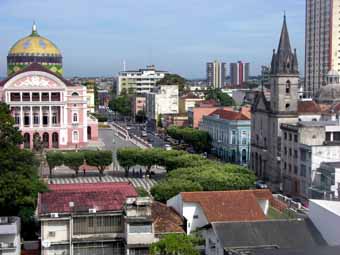 |
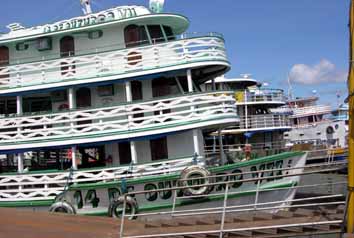 |
At left, Manaus harbor. In a city surrounded by rivers, the main road is the water itself. Dozens of ships like this one take the river everyday, to small towns located everywhere, hundreds os miles way from here. Watching the frantic activities of people embarking in the morning, with all their belongings, and even small animals, is almost a surreal experience, only surpassed by the trip itself, that, depending on the destination, may take several days. |
During summer, the high tide invades miles and miles on both banks of Amazon River, and makes walking impossible in the area. Great part of the jungle turns itself into a sea covered with threes. During this time of the year the canoe is the most important vehicle for everyone, not only tourists but also locals. It’s a nice ride. No traffic noise, no pollution, no stress, just the sound of the water, the blowing of the wind, the buzz of some insects, the always enchanting and surprising music of tropical birds, and maybe a distant roar of some animal. Its hard not to remember that here you are in the middle of nowhere with thousand miles of forest in every direction, and this is really an exciting thought. |
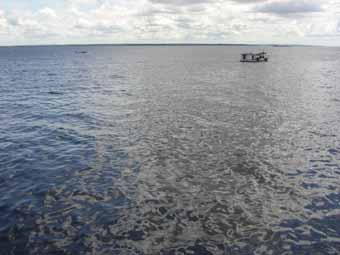 |
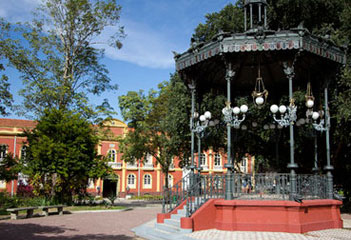 |
In Manaus, this is one more picture of a confortable resort not far from downtown. A good touristic daily tours operators is Fontur, located at the Hotel Tropical and Selvatur (17 Adalberto Square, downtown). Locals enjoy having their snapshots taken, and on a jungle tour you will probably have to chance to meet many of them and their jungle pets. Crafts items, mostly made by Indians or their descendents, can be found everywhere. In Manaus, one of the best places to find souvenirs is around Tenreiro Aranha Square, with a large selection of necklaces, bracelets, woodcarvings, T-shirts, baskets, and handbags. At right, historic central square. |
Picture from the front part of the canoe we were touring the jungle. Not too far from this point we met another long canoe coming back, with an Indian driver at the rear, an old lady with sun glasses in the center, below a kind of sun shelter, and an excited American in the front edge (I suppose he was her husband), with many cameras hanging all around him. When he saw our boat approaching, he smiled and, as a suggestion told us: The next five hundred meters are very good! During this time of the year it rains daily in the Amazon. In the morning and first part of the afternoon it use to be extremely hot and sunny. In the afternoon the sky will slowly turns frightening dark and suddenly it starts to rain. A real tropical tempest, that turned everything around us in dark night. This happened during out boat trip, and it was funny to see how suddenly almost everyone stopped laughing and started to look around worried, as if it was our end, and we were doomed to become a bunch of ship wreck survivors in the meddle of nowhere, or some sort of Tom Hank's Castaway from the Rainforest. But our worries didn’t last long. It stopped raining so fast as it had started, the sun got even brighter and hotter and the fun got even better. |
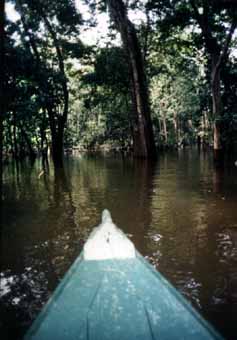
|
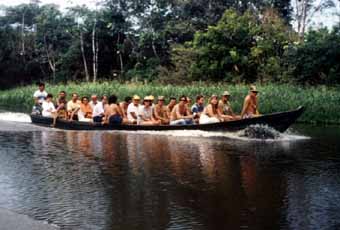 |
An excited group of tourist head to the inner jungle aboard an Amazon canoe. If you have been to Disney World, maybe you remember the Jungle Cruise attraction, where a boat pretends to be sailing in the dark continent, among lions and elephants. Well, this is almost the same, but this one is for real. Also, you won’t find lions and elephants in the Amazon, but many monkeys, panthers, small mammals, snakes and an astonishing diversity of birds. |
|
Manaus serves as starting point for many excursions exploring the central Amazon region. Day trips can be made by riverboat to small villages built on stilts or to hike on foot through the jungle. Several jungle lodges in the vicinity offer a wide variety of Rain Forest programs. One of the most popular boat tours is Encontro das Aguas, at the junction of Negro (Dark) and Solimoes river. Here you can watch their waters junction. They are totally different, Negro has dark waters and Solimoes muddy ones. They join and follow side by side for a hundred miles without mixing their colors. At right, a Rio Negro beach. |
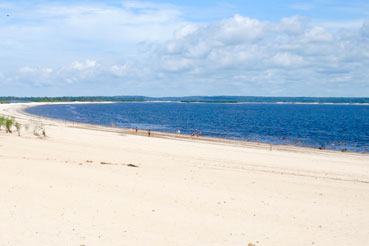 |
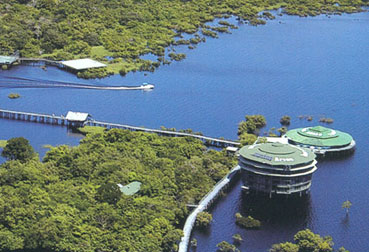 |
Those who prefer not to stay in Manaus hotels have some other options. There are many of this comfortable jungle resorts in the area, where you feel a more intimate taste of the Rain Forest. If you would like to get an aerial view of the forest and the city, contact Viverde, which offers sightseeing flights on a floatplane. It takes off at Tropical Hotel. The shortest trip is a 15 minutes flight over the hotel area, part of the jungle and the Negro and Solimoes rivers. An even better option is the 30 minutes flight over Manaus, the flooded forest and the junction of the waters, which is really an amazing sight from the air. |
At right, sunset at Amazon River. From one bank to the opposite one, the river is ten miles wide at some points. Not surprisingly, it is known as the Sea River. Manaus is located in the central part of the state of Amazonas, north of Brazil. There are no good paved roads linking it to the south and central parts of the country. The best way to get there is by plane. It is a three hours flight from Brasilia, and about five hours flight from Rio or Sao Paulo. All flights arrive at Eduardo Gomes International Airport, ten miles south of downtown from where you can take a taxi or one of the airport shuttles to the city center. Yes, it is hot and humid. and yes, you will probably feel something different in the air. But for sure, you visit to this city located deep in the jungle forest will be an totally new experience, apart from anything you have ever done. |
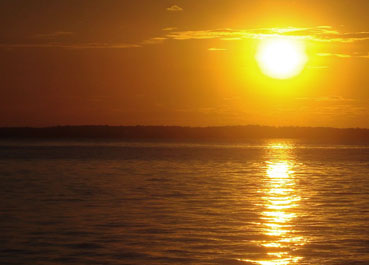 |

|
|
|